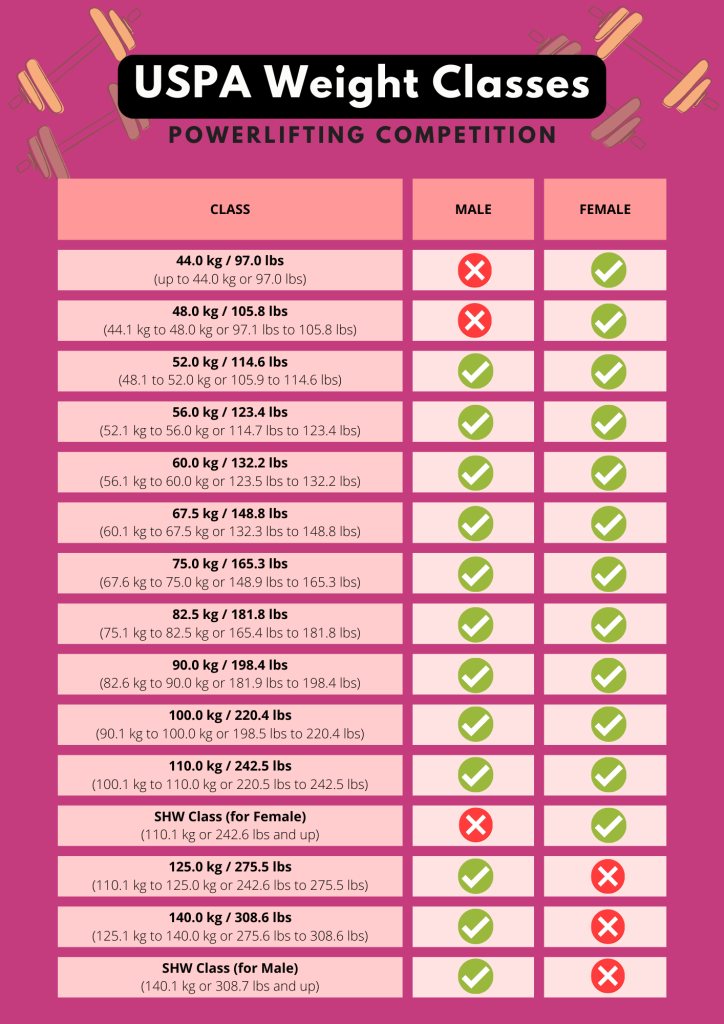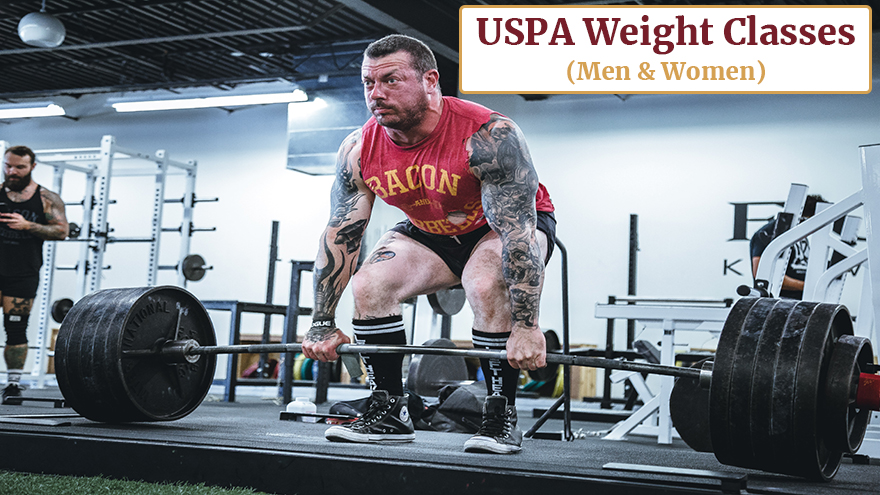USPA weight classes help organize powerlifters according to their weight. In powerlifting competitions, USPA weight classes ensure that only athletes of the same body weight and size compete with each other. Therefore, it guarantees an equal playing field for all lifters.
The United States Powerlifting Association (USPA) has created weight classes for both men and women.
In this in-depth guide, I will try to answer every question you might have regarding the USPA weight classes.
What are the USPA Weight Classes for Powerlifting Competitions?

United States Powerlifting Association (USPA) recognizes twelve weight classes for males and twelve weight classes for females.
Have a look at this updated USPA Weight Classes 2022-2023 Chart.
USPA Weight Classes for Men
- 52.0 kg / 114.6 lbs class (up to 52.0 kg or 114.6 lbs)
- 56.0 kg / 123.4 lbs class (52.1 kg to 56.0 kg or 114.7 lbs to 123.4 lbs)
- 60.0 kg / 132.2 lbs class (56.1 kg to 60.0 kg or 123.5 lbs to 132.2 lbs)
- 67.5 kg / 148.8 lbs class (60.1 kg to 67.5 kg or 132.3 lbs to 148.8 lbs)
- 75.0 kg / 165.3 lbs class (67.6 kg to 75.0 kg or 148.9 lbs to 165.3 lbs)
- 82.5 kg / 181.8 lbs class (75.1 kg to 82.5 kg or 165.4 lbs to 181.8 lbs)
- 90.0 kg / 198.4 lbs class (82.6 kg to 90.0 kg or 181.9 lbs to 198.4 lbs)
- 100.0 kg / 220.4 lbs class (90.1 kg to 100.0 kg or 198.5 lbs to 220.4 lbs)
- 110.0 kg / 242.5 lbs class (100.1 kg to 110.0 kg or 220.5 lbs to 242.5 lbs)
- 125.0 kg / 275.5 lbs class (110.1 kg to 125.0 kg or 242.6 lbs to 275.5 lbs)
- 140.0 kg / 308.6 lbs class (125.1 kg to 140.0 kg or 275.6 lbs to 308.6 lbs)
- SHW class (140.1 kg or 308.7 lbs and up)
USPA Weight Classes for Women
- 44.0 kg / 97.0 lbs class (up to 44.0 kg/97.0 lbs)
- 48.0 kg / 105.8 lbs class (44.1 kg to 48.0 kg or 97.1 lbs to 105.8 lbs)
- 52.0 kg / 114.6 lbs class (48.1 to 52.0 kg or 105.9 to 114.6 lbs)
- 56.0 kg / 123.4 lbs class (52.1 kg to 56.0 kg or 114.7 lbs to 123.4 lbs)
- 60.0 kg / 132.2 lbs class (56.1 kg to 60.0 kg or 123.5 lbs to 132.2 lbs)
- 67.5 kg / 148.8 lbs class (60.1 kg to 67.5 kg or 132.3 lbs to 148.8 lbs)
- 75.0 kg / 165.3 lbs class (67.6 kg to 75.0 kg or 148.9 lbs to 165.3 lbs)
- 82.5 kg / 181.8 lbs class (75.1 kg to 82.5 kg or 165.4 lbs to 181.8 lbs)
- 90.0 kg / 198.4 lbs class (82.6 kg to 90.0 kg or 181.9 lbs to 198.4 lbs)
- 100.0 kg / 220.4 lbs class (90.1 kg to 100.0 kg or 198.5 lbs to 220.4 lbs)
- 110.0 kg / 242.5 lbs class (100.1 kg to 110.0 kg or 220.5 lbs to 242.5 lbs)
- SHW class (110.1 kg or 242.6 lbs and up)
In order to appear in the USPA powerlifting competition, you must weigh in within the restrictions of your appropriate weight class on the day of the competition. Otherwise, you won’t be able to participate in the competition.
How To Determine Which USPA Weight Class To Compete In?
To determine an appropriate weight class to compete in, you must weigh yourself first. After measuring your body weight, check the above given USPA weight chart and select the category range that matches your weight.
Before registering for the USPA powerlifting competition, you must finalize the weight class in which you will compete. This decision can be based on a number of factors, including your gender, body weight, age, height, and strength.
The lightest weight category for men is 52.0 kg / 114.6 pounds and the heaviest is 140.1 kg / 308.7 pounds and up. For women, the lightest USPA weight class is 44.0 kg / 97.0 pounds and the heaviest is 110.1 kg / 242.6 pounds and up.
Each weight class has its own rules and regulations. You can get complete details about the rules and regulations from the official USPA website.
Anyways, if you weigh more than the maximum weight allowed for a weight class, then you cannot compete in that category.
So, choosing the right weight class is important for you as it can affect your performance.
Basically, when athletes choose a weight class that is too heavy or too light, they may not be as strong as other athletes in their class. In turn, they may be less likely to place in competitions or receive medals.
Athletes should consult a trainer or other experienced weightlifter to help them choose the right weight class. This decision can affect an athlete’s performance in a competition. With the help of a trainer, athletes can find the right weight class for them.
What Are the Benefits of Competing in a Weight Class?
Competing in an appropriate weight class is a great way to enhance your performance. It enables you to focus on improving your technique instead of getting demotivated by competing against more heavyweight or senior lifters.
You will also have the opportunity to get feedback from other lifters of the same weight class.
Athletes having similar size and strength help create a level playing field and fairer competition.
Are There Any Penalties for Competing in the Wrong Weight Class?
According to the United States Powerlifting Association (USPA), there are no penalties for competing in the wrong weight class. But, if a powerlifter participates in a weight class that is not his own then his lifts will not be considered when calculating the final score.
How Often Can You Compete in a USPA Weight Class?
There is no restriction on how often you participate in a USPA weight class. Their only requirement is that an athlete must belong to his selected USPA weight class.
You can also have a look at USPA’s upcoming events to learn more about the frequency of your desired USPA powerlifting competitions.
What Is the Process for Changing Your Weight Class?
You need to follow a specific process in order to change your USPA weight class. Here’s a step-by-step guide I’ve created for you.
- Create an application where you mention your registration details, current weight, desired weight class, and justification for making the change.
- Now, submit this application to the USPA office.
- Your application will be reviewed by the USPA Competition Committee.
- If your request is approved by the committee, you will be moved to the new weight class and can compete in future events. If the committee denies your request, you will not be able to compete in a different weight class until you meet the requirements set by the USPA.
Important Note: You can only change weight classes yearly. So, if you are considering making a change, plan and submit your application well before your desired competition date.
Who Makes the Final Decision on What Weight Class a Competitor Competes In?
The whole decision-making authority belongs to the event organizer i.e. USPA official staff.
There are some factors that the USPA considers when making decisions about weight classes. These are as follows:
- Body weight
- Height
- Age
- Gender
Conclusion
USPA weight classes are created to promote a level playing field in powerlifting competitions.
Powerlifting is no doubt a great sport for anyone who wants to show off physical strength. But, you must make sure that you are training properly and eating a healthy diet before registering for the USPA competition. It will definitely increase your chances of success.
Also, remember that you need to follow the USPA rules and regulations to participate in the competitions.
Thanks for reading!

